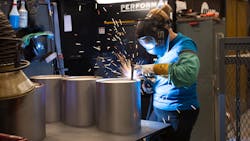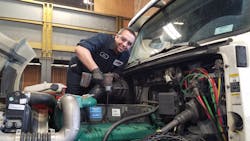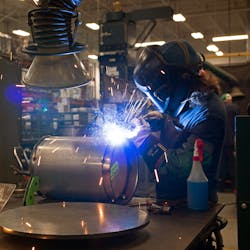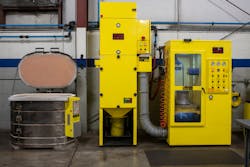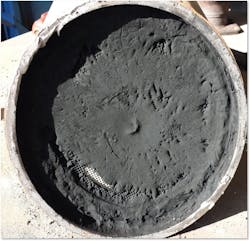The diesel particulate filter (DPF) and other aftertreatment system (ATS) components have greatly improved over the last 10 years. Still, DPF-related issues continue to cause headaches for fleets.
“A fleet will never get the longevity out of an early ATS (2007-2015) like it will with today’s systems,” said Bruce Balfour, vice president of Clean Diesel Specialists (CDS), a diesel emissions service and equipment company. “And when it comes to newer vehicles and achieving the really extended cleaning intervals talked about today, it’s all about the vehicle’s duty cycle and any upstream problems the engine has.”
Environmental and climate factors also can affect DPF maintenance requirements.
“I have seen far fewer aftertreatment issues now that I am in Arizona compared to what I saw when I was working in Chicago,” said John Norwood, a technician at Aim NationaLease in Phoenix. Norwood recently competed in the TMCSuperTech challenge, to where he placed first in the engine and ATS station.
Whatever the root causes, it’s a technician’s job to identify why DPF issues are happening.
“The trick to dealing with DPF problems is figuring out how to make sure everything upstream of the DPF is working within certain boundaries the DPF can deal with,” said Kevin Otto, a technical consultant to the heavy-duty industry. Otto serves as a technical adviser to the North American Council for Freight Efficiency (NACFE) after retiring from Cummins.Upstream uncertainties
Norwood’s process for troubleshooting DPF failures always involves heading upstream.
“Sometimes a DPF in need of cleaning is the failure because the DPF system can affect the SCR [selective catalytic reduction] system,” Norwood said. “Other times it might be an issue with the EGR [exhaust gas recirculation] system. Sometimes it’s a fuel issue. I tend to start with oil samples if they are available, and then match that with codes and how the engine is running.”
See also: What does your engine aftertreatment service plan look like?
An engine oil consumption problem will be hard on a DPF. As Otto explained, the additives in engine oil cannot be oxidized away during a regen, thus leaving behind a lot of ash. Similarly, DPF issues will likely arise when a head gasket failure results in coolant leaking into the power cylinder or exhaust stream.
Otto also agreed with Norwood that the EGR system can cause DPF issues.
“At Cummins, we’d classified EGR as part of the air-handling intake system which includes the EGR valve, EGR plumbing, charge air coolers, turbochargers, intake air filters, and related components,” Otto said. “If any of those components fail and you let them get out of hand, you’ll start making more smoke, which puts more burden on the DPF.”
TMC Recommended Practice 355A points out some things a technician can do to catch ATS issues before they result in DPF failures. During routine PM inspections, technicians can visually check:
- Intake system
- Cooling fan
- Exhaust system (EGR, connections, tailpipe, etc.)
- DPF system (damaged gaskets, hangers, loose clamps, etc.)
- Sensors and connections
- Fuel doser and lines
- Physical damage to the DPF
Additionally, no soot should be observed on the outlet side of the DPF; just a light brown color. Some level of soot will be observed on the inlet side, but should be black and relatively dry. This is a good time for a technician to also look for missing or damaged end plugs, as well as cracks in the substrate.
Issues like this should be identified before a technician forces a regen.
“Many technicians use a forced regen as their first repair attempt when a fault code indicates an issue with the ATS,” said Lee Lackey, product manager with Noregon Systems, a provider of diagnostic, repair, and data analytic solutions. “But forcing a regen uses a considerable amount of fuel, typically a gallon or more. Additionally, forcing a regen causes undue stress to the components, weakening them and shortening their lifespan.”Lackey said technicians should take the time to utilize the troubleshooting functionality of their diagnostic tool. “In JPRO, for example, we provide a checklist of items to follow before starting aftertreatment diagnostics. As a rule of thumb, focus on issues upstream of the DPF that can lead to contamination of the filter. This means diagnosing any active engine faults before aftertreatment faults,” Lackey advised.
“Depending on the fault codes, a regen might be the answer 80% of the time,” added Chris Freeman, director of sales/training HD at Autel, a developer of diagnostics, detection, and analysis systems. “But technicians must understand that a regen is not the cure-all for DPF and ATS issues. Technicians should read their troubleshooting steps completely in order to identify the root cause of a code or series of codes.”
Freeman recently assisted a customer with an ATS-related issue that helps illustrate his point. A Cummins engine had gone into derate (codes 3712 and 3714). Freeman helped the technician troubleshoot by process of elimination.
“I knew this engine didn’t have issues with the EGR valve, so I set that possibility aside,” Freeman explained. “A problem with the VGT (variable geometry turbocharger) actuator is it typically throws its own code. There wasn’t a code, so I set that aside. What’s left? The DPF, DOC (diesel oxidation catalyst), and SCR filters go bad because of something else that’s happening. So I set those filters aside as the root cause. Now I’m focused on the DEF (diesel exhaust fluid) and NOx sensors.”
This truck had a dozen active codes. Freeman found one that said DEF quality was insufficient at the downstream NOx sensor. The doser is directly upstream from that sensor, so Freeman knew the DEF wasn’t concentrated enough.
“I began reviewing the repair information that is included with our diagnostic tool,” Freeman related. “I saw that this particular code can happen when the DEF tank is refilled. So I checked the DEF tank and saw that it was full, but the fuel tank was only a quarter-full, which is odd.
“The repair information also says a regen can solve this issue, so I attempted that,” Freeman continued. “As I’m watching my computer screen, I see that the doser is going back and forth between 0 and 50 psi. That suggests a problem with the doser line. After it ran a while, the pressures came back up to 120 or 130 psi like they should.”
As it turned out, the driver had allowed the vehicle to run out of DEF, forcing the vehicle into derate. The driver then refilled the DEF before calling the shop. But in the meantime, air had built up in the doser line, causing the DEF quality code to trigger. Once this root cause was solved, Freeman helped the technician follow the repair procedure to properly clear the 3712 and 3714 codes, which includes three engine cycles so the ECM can perform a self-test.
As with unnecessary forced regens, sometimes a technician’s instinct is to react to a fault code by swapping out a part. But on a vehicle with multiple ECMs, understanding the entire layout is key.
“When you get an aftertreatment code, it could be the DPF, the DEF, or maybe none of the above,” said Bruno Gattamorta, vice president of sales and marketing for Cojali USA, a provider of diagnostic tools and other technologies. “With our Jaltest Troubleshooting Guides, there is an option to troubleshoot by symptoms as opposed to fault codes. So maybe there’s a problem with the injectors dosing too much and causing a problem in the combustion chamber. Then the EGR valve functions out of sync and there’s a snowball effect. The code is for the aftertreatment, but the problem is really the engine. Having the right diagnostic tool to show a holistic view of the vehicle can be the difference between a one-hour fix and an endless array of parts, dealer trips, and frustration.”
See also: Why fleets should bypass the urge to bypass aftertreatment systems
Tailoring maintenance to DPF needs
In addition to upstream problems, there are certain applications that place extra burden on a DPF.
“An emissions system needs three things: time, temperature, and pressure,” said Chris Hough, vice president of maintenance design and engineering for Penske Truck Leasing, a provider of commercial truck leasing, fleet maintenance, truck rentals, and used-truck sales. “If you don’t give the system enough time to build up enough heat and pressure, it is never going to cleanse itself (passive regen). A truck hauling a heavy load from coast to coast will likely have very limited DPF issues because it has the time to do what it needs to do. On the other hand, a city delivery vehicle may run into a lot of issues.”
As discussed in TMC RP 355A, numerous factors can influence DPF maintenance intervals, including:
- High oil consumption
- Increased engine wear on higher-mileage engines
- Sulfur level of diesel fuel in excess of 15 ppm
- Certain supplemental oil and fuel additives
- Engine failures (i.e., turbocharger, wear metals, fuel injectors, etc.)
- Boost and intake leaks
- Malfunctioning or plugged dosing injector valve
- Duty cycle (i.e., low-load operation or extended idling)
“If you’ve waited for the engine ECU to tell you the DPF is dirty, you’ve waited too long,” said Ryan Koukal, chief operating officer at CDS. That’s why CDS recommends cleaning every 100,000 miles, or every year. On lower duty-cycle vehicles, CDS recommends having the DPF cleaned every 1,000 miles. Koukal said more frequent cleanings are worth it because a clogged DPF can lead to reduced fuel mileage, additional ATS issues, and downtime that can cost a fleet even more money.
Koukal said technicians should check and adjust maintenance intervals as conditions warrant. “If a technician cleans a DPF at 100,000 miles but it isn’t too dirty yet, maybe the interval can extend to 150,000 miles. The main thing is to get on a routine that is based on that DPF’s needs,” he explained.
Tips on DPF cleaning
With an effective cleaning, Hough said it is not unusual to restore a DPF to 90% capacity. The key is making sure the DPF is cleaned as thoroughly as possible.
“Sometimes a technician can get away with just blowing a DPF out,” Koukal added. “But most of the time, the filter needs to be put through a regeneration in an oven. Baking a filter is what breaks down the molecule of the soot particle, which eases the process of cleaning it with air.”
According to Koukal, more fleets are now demanding the aqueous method of cleaning.
“This is basically the same process as using air, only the technician uses water,” Koukal explained. “Cleaning a DPF with water is much more effective. If you bake a DPF and use air, it may take two or three rounds to get it clean. With the aqueous method, there’s a much higher chance of getting it clean on the first try.”
Regardless of the method used, Koukal said the technician’s attention to detail is the critical factor.
“Our cleaning system is unique in that it’s a manual system,” Koukal said. “The technician is actually inside the machine cleaning the DPF with their own hands and eyes. This is different than most of the equipment out there that is automated.”
According to Koukal, the hands-on aspect helps provide another level of quality control. When a filter comes out of an automated cleaning machine, a certain amount of soot may have been left behind that leads the technician to prematurely condemn the filter. Because the technician didn’t physically perform the cleaning, there is no recognition that the filter could be cleaned a bit better.
“Depending on how a DPF is mounted or how the exhaust flows through it, you can get problem areas on a DPF,” Koukal explained. “A DPF doesn’t get dirty uniformly, so cleaning it uniformly doesn’t really make a lot of sense. A technician may have to spend 15 minutes in a 5-inch-diameter circle because that area has a lot of compacted soot and ash.”
Koukal pointed out a few tests to help technicians confirm that a DPF has been cleaned adequately. The technician can weigh the DPF before and after cleaning to measure how much soot and ash was removed.
“Another effective test is what we call a tap test,” Koukal said. “The technician takes the cleaned DPF with the inlet side facing down, lifts it off the ground an inch, and drops it. The DPF will bounce and rattle a bit. But if a lot of particulate matter is still stuck to the filter, the technician will see a ring on the ground.”
Another essential test is to shine a bright light on the DPF. “Our (Enviromotive) cleaning machine has a built-in, high-lumen light to help detect internal cracks or other damage,” Koukal said. A technician could also use a high-lumen flashlight.
Tapping into technology
It’s important for technicians to stay on top of software updates. “You never know when an update includes something designed to improve ATS performance, perhaps something DPF-specific,” Otto said.
Case in point, the nationwide computer chip shortage has created some ATS issues. As Noregon’s Lackey explained, component manufacturers gained approval from the EPA in the fall to reprogram their systems to ignore DEF quality sensors that would typically derate a truck upon reaching a defined threshold. That is because the chip shortage is making it impossible to replace faulty DEF sensors.
“Fleets should ensure that all truck components are operating the latest software versioning to help mitigate side effects from the supply shortages,” Lackey advised. “Updating can be done over the air in many cases, or during the truck’s next physical diagnostic connection.”
Lackey said technology can also help fleets alleviate supply chain headaches through analytics and forecasting.
“For example, we’ve learned from analyzing fault data that one manufacturer’s engines consistently register a fault around 400,000 miles, advising that the DPF be replaced,” Lackey said. “Instead of being caught off guard with limited options due to supply chain issues, projecting maintenance issues like this gives the fleet more time to order parts and not rely on just-in-time delivery when the fault occurs.”
Remote diagnostics, Lackey added, are an excellent first line of defense against issues like this. “Using a tool like TripVision Uptime, fleets can set alerts for certain faults—such as high soot level—and take immediate action when one becomes active,” he said.
“Components in low supply should be treated as more important than in normal times. If a truck needs to be downed for a DPF-related maintenance issue, fleets should consider downing it sooner to prevent longer-term damage to the system,” Lackey continued.
To get to that point, fleets need to get on a good DPF maintenance routine that is more proactive than reactive. And when they get on a proactive routine that is customized to a given vehicle’s actual needs, that’s even better.
About the Author

Gregg Wartgow
Gregg Wartgow is a freelancer who Fleet Maintenance has relied upon for many years, writing about virtually any trucking topic. He lives in Brodhead, Wisconsin.
